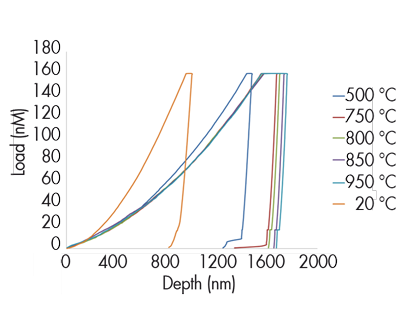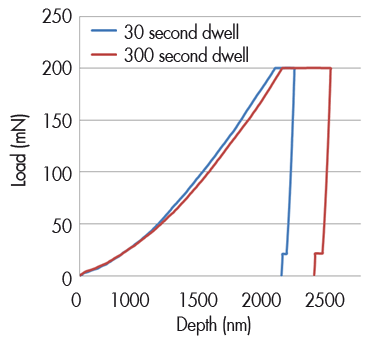High-temperature nanoindentation of tungsten at temperatures up to 950 °C

For the first time nanoindentation measurements were performed in a vacuum environment where both the sample and the indenter were heated to 950 °C. The measurements were performed on single-crystal tungsten samples at the following temperatures: Room temperature, 500 °C, 750 °C, 800 °C, 850 °C, 900 °C and 950 °C. [1]
The high-temperature nanoindenter NanoTest Xtreme was successfully used to perform high-temperature experiments on tungsten in vacuum at temperatures to 950 °C. The further development of this technology promises temperatures around 1000 °C and higher.

Fig. 1: Indentation data in a single crystal tungsten sample at 20, 500, 750, 800, 850, 900 and 950 °C in vacuum
Nanoindentation is already successfully used to characterize the surface properties of tungsten-based alloys. One of the most promising materials for the cladding of nuclear fusion reactors. Until a few months ago, the only results published were those of measurements with maximum temperatures of 750 °C as this was the limit for high-temperature nanoindentation. Fig. 1 shows the penetration depth hysteresis data from room temperature to 950 °C. Thanks to the precise control of both the sample and indenter temperatures, there is no noticeable change of data quality over the entire temperature range. The high-temperature nanoindenter NanoTest Xtreme was successfully used to perform high-temperature experiments on tungsten in vacuum at temperatures to 950 °C. The further development of this technology promises temperatures around 1000 °C and high

Fig. 2: Increasing penetration depth during the 30 seconds long dwell time at maximum load for indents at 750, 850 and 950 °C
The data confirms a very quick initial material softening, followed by a continuous temperature decrease above 500 °C. The analysis shows a decrease of hardness from 6 GPA at room temperature to almost 2 GPa at 950 °C. With rising temperatures and the corresponding material softening, an increase of the penetration depth can be observed during the maximum load dwell time. Fig. 2 shows this increase for a dwell time of 30 seconds. The elastic modulus of Tungsten at room temperature is 411 GPa. Literature mentions a decrease of the elastic modulus by approx. 10% in the range 20 - 1000 °C. First experiments with a dwell time of 30 seconds showed that the elastic modulus had increased to 550 GPa at 950 °C.

Fig. 3: Comparison of 30 and 300 second long dwell times at maximum load for two indents at 950 °C
As a consequence, the dwell time has been extended to 300 seconds so that the tungsten can creep completely before it is unloaded (Fig. 3). The extraordinary stability of the measuring device allows reliable measurements. At the longer dwell time, the reduced modulus decreases to 260 GPa at 950 °C. This correlates with an elastic modulus of 370 GPa which is consistent with the 10% decrease mentioned in technical literature.
1 Extreme nanomechanics: Vacuum nanoindentation and nanotribology to 950 ºC AJ Harris, BD Beake and DEJ Armstrong (under review)
2 G. Simmons, H. Wang: Single crystal elastic constants and calculated aggregate properties; a handbook. 2nd edn; 1971. Cambridge, MA, MIT Press


